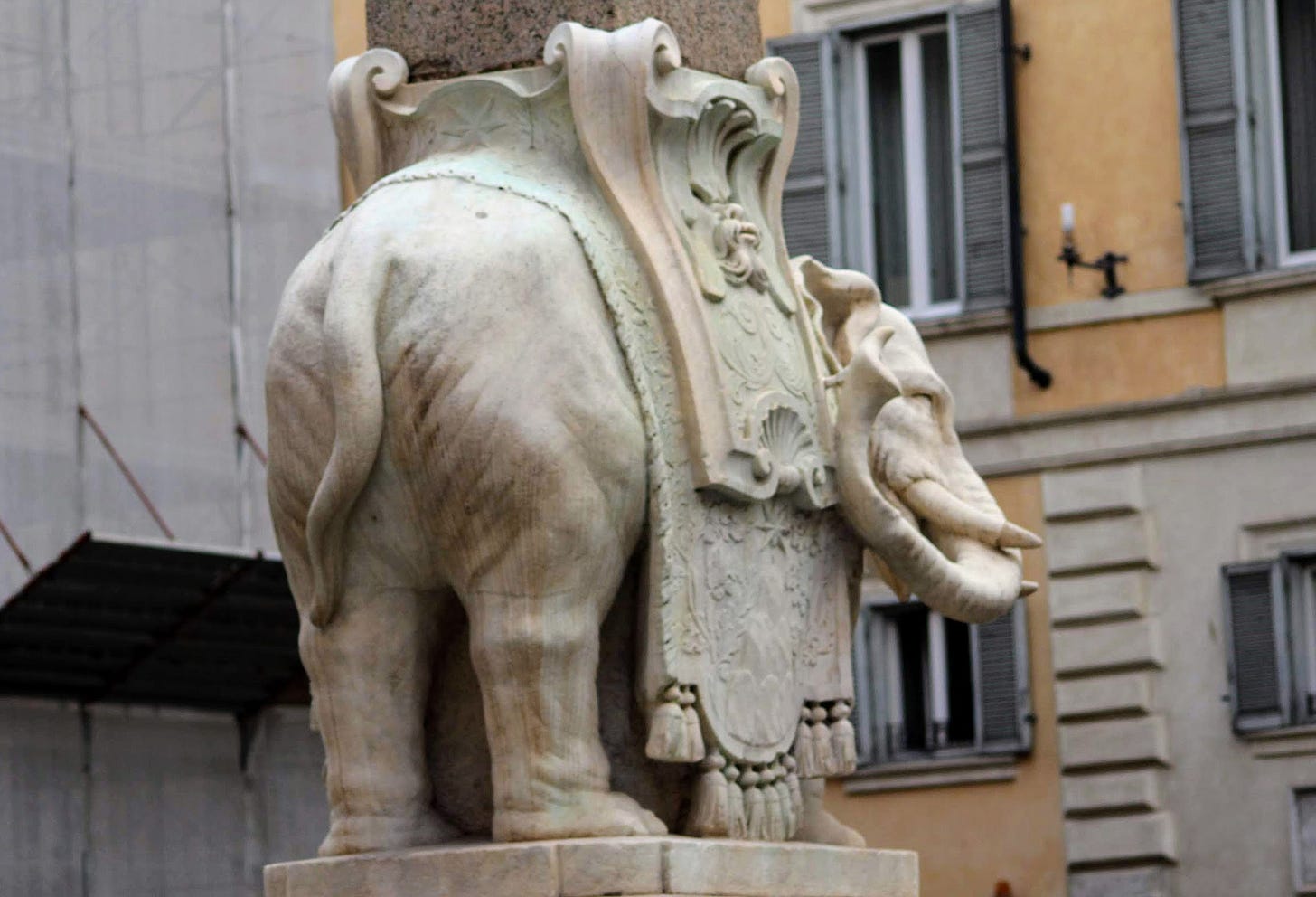
Heads up: This post may be truncated for some subscribers. If you’re reading this in your inbox, click on "view entire message" at the bottom of this page and you’ll be able to view the entire post.
“The Elephant in the Room” can be literally translated as “l’elefante nella stanza” or “l’elefante nel salotto” in Italian. Though, from what I understand, it is known only as a translated English phrase. Instead, Italians might use “convitato di pietra” (the stone guest, as featured in Mozart’s Don Giovanni) or “il segreto di Pulcinella” to describe a thing or situation that everyone is aware of but no one discusses or acknowledges, despite its oversized presence.
So what is the elephant in the room? For me, at least, the elephant is writing about Italy without mentioning its recent election.
Following the election in late September of Italy’s first far-right government since World War II, there has been a lot of (justifiable) concern in Italy, Europe, and beyond. Giorgia Meloni’s Fratelli d’Italia (the Brothers of Italy), a party that draws its roots from Italy’s fascist past, formed a coalition with the Lega Nord and Forza Italia, led, respectively by Matteo Salvini and Silvio Berlusconi.
Although Italy’s first female prime minister tried to appear as a moderate throughout the election campaign, there are already signs that it was just window dressing. One of the biggest red flags was the recent ban on raves, a vaguely-worded law that critics say could lead to the government banning sit-ins, gatherings, and other forms of protest.
The decree, which still must be debated and approved by parliament to become law, would make the organizers of unauthorized gatherings of more than 50 people in public or private settings eligible for prosecution and prison terms of up to six years. -AP
The Modena rave that sparked this new decree took place on the same day that several thousand fascist sympathizers marched into the town of Predappio to commemorate Mussolini at his family’s crypt. Dov’era lo stato?, asked lawyer, author, and critic Cathy La Torre—where was the state then?
Mussolini fans have also gotten jobs in Meloni’s new government. According to Politico, “Galeazzo Bignami, the new deputy minister for infrastructure, was photographed [around 2006] in a black shirt and a swastika armband.” Meanwhile, a junior economics minister “suggested that a park named after assassinated anti-mafia judges Giovanni Falcone and Paolo Borsellino should be renamed after Benito Mussolini’s brother”; “the new junior education minister, Paola Frassinetti, was pictured in 2017 attending a banned march honoring Italian SS volunteers at a cemetery in Milan; and “another junior minister, Augusta Montaruli, was pictured on a pilgrimage to Mussolini’s birthplace, with a group carrying the black cross flag used by neo-fascist white nationalist groups worldwide.”
All of this happened on the 100th anniversary of Mussolini’s March on Rome, the de facto coup d’état that brought him to power on October 28, 1922. “The March on Rome was not the conquest of power that Mussolini later called it but rather a transfer of power within the framework of the constitution, a transfer made possible by the surrender of public authorities in the face of fascist intimidation.”
Modeling himself after Julius Caesar, Rome’s first dictator, Mussolini believed he was the heir to a new Roman Empire. Monuments were erected, Latin was used to link the regime to Ancient Rome, and many symbols from Ancient Rome were appropriated, including the fasces, the word that gave us fascism.
In ancient Rome, the word fasces referred to a weapon consisting of a bundle of wooden rods, sometimes surrounding an ax. Used by Roman authorities to punish wrongdoers, the fasces came to represent state authority.
—How Mussolini led Italy to fascism—and why his legacy looms today | National Geographic
Mussolini—and many politicians throughout history and the present—used another idea from Ancient Rome: Divide et Impera or Divide and Rule. In English, we usually say “Divide and Conquer.”
Merriam-Webster defines Divide et Impera as the strategy of “split[ting] the opposition so that it ceases to threaten your own power.”
“Mussolini wrote the playbook on how to destroy democracy,” explains this PBS documentary. The trailer is here:
The Road to Dictatorship
Mussolini built fascism into a movement, complete with a paramilitary force: the blackshirts. Thirty thousand blackshirts marched on Rome in 1922, seizing government buildings and train stations along the way.
Already a member of parliament, Mussolini demanded to be made prime minister—and Italy’s king capitulated. Once in power, Mussolini began a systematic effort to weaken the country’s fragile democracy.
A former journalist, Mussolini was a gifted writer with an instinct for playing on people’s dreams and fears. He connected with the public at mass rallies—and through the power of a new technology, radio.

As you know, I adore Italy—sometimes even more than I love my own country, the USA. Both countries feel like home to me.
I am sad about the current political situation in Italy. But being an Italy tourism booster, rather than an actual voter, doesn’t afford me many opportunities to comment on Italian politics. I’ll admit I’m not even super knowledgeable about Italy’s election process. But I know enough to know that those who do not know history are doomed to repeat it.

I am hardly the only one who sees parallels between fascist Italy, post-fascist Italy, and current-day United States.
In the same week that right-wing Italians commemorated the March on Rome centennial, with some even hanging a pro-Mussolini banner near the Colosseum, Americans saw hate groups hang an antisemitic banner over an LA highway and project the same message onto a stadium in Florida. “While antisemitism in high places in the GOP is not new,” explains David Rothkopf, “the embrace of antisemitic tropes, anti-Jewish bigots, and silence in the face of antisemitism is stunning in its brazenness.”
Also in the same week, Paul Pelosi, the 82-year-old husband of the Speaker of the House Nancy Pelosi, was attacked in his home with a hammer. Many on the right made jokes about the attack on the campaign trail. The cruelty is the point.
Nevertheless, I think that there is now a feeling among undecided voters and non-voters that we should give the other guy or gal a chance to lead. “What’s the worst that could happen? It’s only for a few years.”
Mussolini's first act as prime minister was to demand special emergency powers allowing him to rig elections in the Fascists' favor. (Does that sound familiar?)


Fascists ruled Italy from 1922 until the end of World War II. During that time, women were turned into baby/soldier-making machines; the state suppressed dissent and promoted violence, and the opposition (anti-fascists) was jailed and/or killed. In a move to impress and attempt to contain Hitler, Mussolini introduced racial laws that targeted Jews, Africans, and anyone deemed not Italian enough.
I really fear that we are heading backward, towards 1922. We are stumbling, as Seneca warned, over something that is behind us.
“It is easier to tell a story about a glorious past that people vividly remember (and misremember) than it is to tell the story of a future they can’t yet see and may not believe can be delivered. It is easier to simplify and scapegoat than to propose actual solutions to complex problems.”
But we need to look ahead. We need to hope. And, we need to vote. Our lives and the lives of our family, friends, and neighbors, depend on it.
Thank you for letting me use my platform to speak to my fellow American citizens. Although this is a newsletter about Italy, I believe that we are a global community. And, for better or worse, what happens here in the U.S. can have repercussions in the rest of the world.
I write this post sincerely. And, though I may be preaching to the choir, I hope that I am able to reach others with my earnest appeal to vote for decent people whose mission is to protect our fragile democracy. Here are a few of those decent people that deserve your vote:
If you appreciated this post, please subscribe.
You can also purchase a t-shirt.
Additional Resources
I linked to a ton of reading material in this post. But there were some links above that I wanted to highlight again as well as other resources I wanted to share that I just couldn’t fit in.
Bloodshed In Riots Throughout Italy, Many Are Killed (NYT, November 3, 1926)
Who Goes Nazi? (Harper’s Magazine, 1941)
A Brief History of Anti-Fascism by James Stout
The Cruelty Is The Point by Adam Serwer
Weapons of Mass Delusion: When the Republican Party Lost Its Mind by Robert Draper
Strongmen: Mussolini to the Present by Ruth Ben-Ghiat
Mussolini’s Italy: Life Under the Fascist Dictatorship, 1915-1945 by R.J.B. Bosworth
Twelve Caesars: Images of Power from the Ancient World to the Modern by Mary Beard
Resistance and Remembrance: The Importance of Liberation Day in Italy







